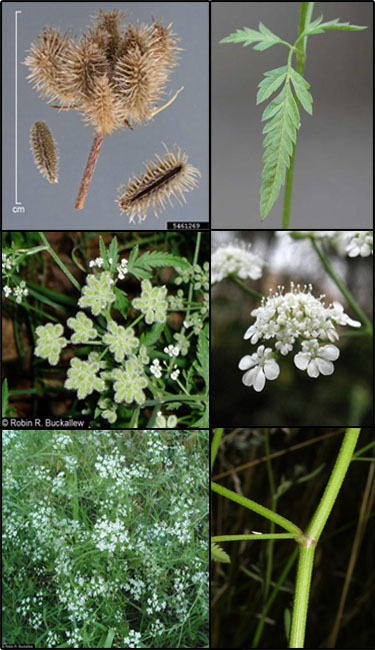Field hedgeparsley (Torilis arvensis)
 Common Names: Spreading hedgeparsley
Common Names: Spreading hedgeparsleyDescription: Plant contains burs that stick to the fur and hair of animals and can cause injury by lodging in the noses, eyes and ears of pets and livestock. This plant is also suitable as bee pasture.
Habit: Erect, annual, grows 2-4 ft (0.6-1.2 m) tall; first year rosettes are low, parsley-like, green in to the fall; taprooted.
Leaves: Alternate, petiolate, narrowly triangular in outline, two or three times pinnate, the ultimate segments narrowly lanceolate.
Stems: Slender, spreading or erect, branched, round, green in color, covered with fine hairs that are white and short.
Flowers: Inflorescence of compound umbels, with few to several rays; involucre bracts 0 or small, white in color with a pinkish tinge, 5 petals of somewhat unequal size; blooms July through September.
Fruit and seeds: Small, cylindrical and covered with hooked hairs.
Habitat: Native to Eurasia. Found in waste grounds, disturbed sites, thickets, roadsides, railroads.
Reproduction: By seed or vegetatively by clonal colonies.
Similar species: Queen Anne's lace (Daucus carota); Japanese hedgeparsley (Torillis japonica).
Monitoring and rapid response: Hand-pull or mow before flowering. Treat foliage with glyphosate or triclopyr in early spring and when re-sprouting after cutting; monitor the site. Credits: The information provided in this factsheet was gathered from the Burke Museum of Natural History and Culture, the Jepson Treatment Manual and the University of California.
Individual species images that appear with a number in a black box are courtesy of the Bugwood.org network (http://www.invasive.org).Individual photo author credits may not be included due to the small display size of the images and subsequent difficulty of reading the provided text. All other images appear courtesy of Google (http://images.google.com).
